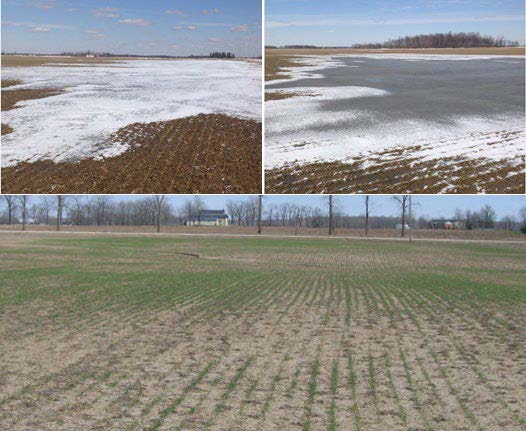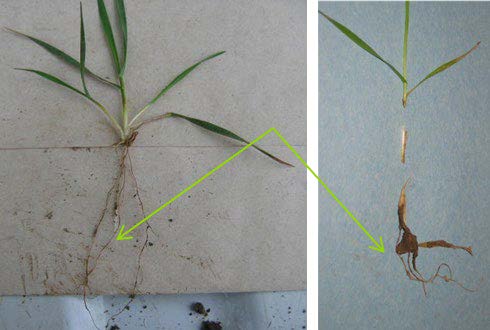Winter wheat can be challenged with a wet fall, an early winter, and severe freeze-thaw cycles. This can result in “winter kill” where the wheat plants die due to:
Frost Heaving: As the frost goes into the ground, it gets underneath the crown and ‘heaves’ or lifts the crown out of the ground. The freeze-thaw cycle continues throughout the winter and with every cycle it can heave the wheat further out of the ground. This process breaks the roots and causes the plant to die. Freeze-thaw cycles are particularly problematic if they happen in March or early April when wheat is exiting dormancy.
Ice and Ponding: If ice forms in thick sheets over the wheat, it prevents the wheat from getting oxygen. Ponding water has a similar effect. The plants cannot survive without oxygen and will suffocate. Dormant wheat will only survive without oxygen for approximately two weeks.
Extreme Cold: When the wheat experiences extreme cold without the insulation of snow cover, the plant tissue may be destroyed. Stressed plants are more susceptible to extreme cold than healthy ones.
Typically, the fields that are most affected are:
- heavier clay soils
- later planted wheat that has both low crown growth and depleted seed reserves is more at risk
- those with loose soil at planting, poor seed to soil contact
- inconsistent snow cover during the winter
- those with drainage issues, where water tends to pond

How much of the field is affected?
- Rarely are fields uniformly affected by winter kill.
- Holes are the hardest thing to assess in these fields. It takes a tremendous amount of walking to get an accurate idea of the amount of the field affected. Count paces as you walk across the field. For each 100 paces, record the number of paces with no or very poor wheat. After a “W” or “Z” walking pattern, you can use these numbers to calculate the percentage of the field that has poor wheat.
- If 30% or more of the field is affected by winter kill, it is best to replant to another crop.
How many plants do I need?
- A target population of 7-10 plants per foot of row in most cases will produce 90-95% of yield potential. The 7-10 plants per foot of row must be in good health. See below for methods on determining plant health.
Methods to Evaluate Plant Health
- Dig up several plants with as many roots still attached as possible, shake each seedling free of excess soil; if soil adheres to roots, the root hairs are probably alive, as is the plant.
- Cut into the crown at the base of the plant and expose the tissue; if the crown tissue is white or light green, the plant is alive; if it’s brownish, it’s dead. (See photo below where the crown is white.)

Planting Date Matters!
- In early planted wheat fields with 7 plants per foot of row can be kept. In late planted fields a stand of 9-10 plants per foot of row is necessary to keep the field.







